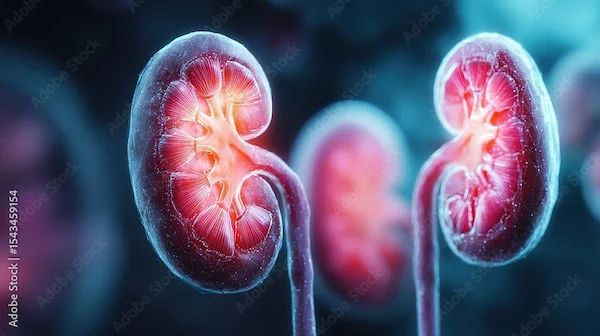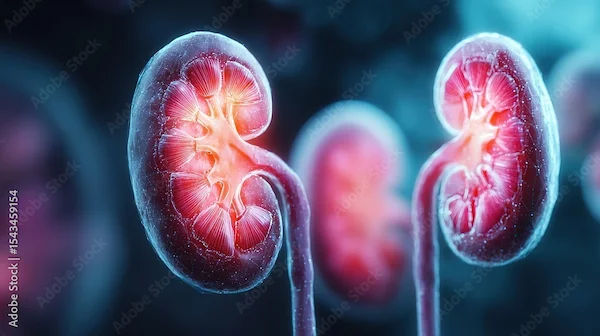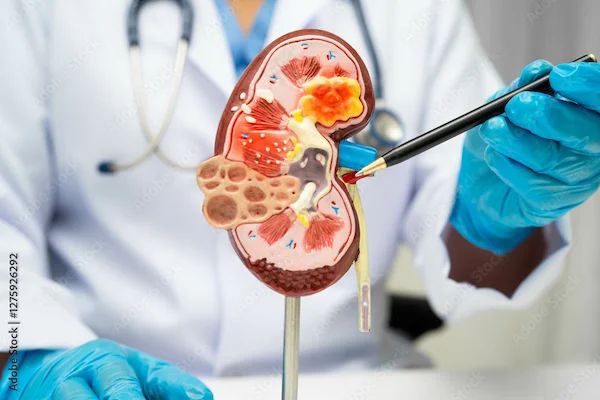Kidney Health and Hydronephrosis
Learn about hydronephrosis and its causes, symptoms, and treatment options. Understand how to manage and prevent kidney health effectively.

Written by
Last updated on 3rd Jul, 2025
Introduction
Kidney health is crucial to overall well-being, as the kidneys are responsible for filtering waste, balancing fluid levels, and maintaining essential electrolytes in the body. However, when the kidneys face issues, it can result in conditions that compromise their function. One such condition is hydronephrosis, a problem that occurs when the kidneys become swollen due to the buildup of urine. Understanding how hydronephrosis develops, its causes, symptoms, diagnosis, treatment, and prevention strategies can help you manage and protect your kidney health.
What is Hydronephrosis?
Hydronephrosis occurs when one or both kidneys swell as a result of urine buildup. This can happen when there is an obstruction or blockage in the urinary tract, preventing urine from draining from the kidneys to the bladder. The pressure from the trapped urine causes the kidney to enlarge, potentially leading to kidney damage or dysfunction.
While hydronephrosis can affect people of all ages, the condition is particularly common in infants and can also develop in adults as a result of various medical conditions. In some cases, hydronephrosis can be mild and resolve on its own, while in others, it can lead to more serious complications that require medical intervention.
Kidney Function and the Role of Hydronephrosis
The kidneys are vital organs responsible for a range of crucial functions that keep our bodies running smoothly. Each kidney contains tiny structures called nephrons, which filter waste products and excess fluids from the bloodstream, maintaining a balance of electrolytes, salts, and fluids.
One of the key roles of the kidneys is regulating blood pressure. They do this by managing the balance of salt and water in the body and releasing an enzyme called renin, which helps control blood pressure levels. Additionally, the kidneys produce erythropoietin, a hormone that stimulates the production of red blood cells in the bone marrow. This is essential for ensuring that the body has enough oxygen-carrying capacity. The kidneys also convert vitamin D into its active form, calcitriol, which is crucial for maintaining healthy levels of calcium and phosphorus in the blood and supporting strong bones.
Hydronephrosis can really take a toll on kidney health by interfering with their vital functions. The pressure from the trapped urine can damage the nephrons, which can lead to a gradual decline in kidney function. That’s why it’s so important to address hydronephrosis quickly—doing so can help prevent lasting damage and keep your kidneys working properly.
How Hydronephrosis Develops
Hydronephrosis typically results from a blockage or obstruction at some point along the urinary tract. The blockage can occur in different areas, including:
Ureters: The tubes that carry urine from the kidneys to the bladder can become blocked by kidney stones, blood clots, or tumours. This prevents urine from flowing freely, causing the kidneys to swell.
Bladder: Conditions like an enlarged prostate in men or neurological issues that affect bladder control can prevent the bladder from emptying properly, which puts pressure on the kidneys.
Urethra: Blockages in the urethra—the tube that carries urine from the bladder out of the body—can also result in hydronephrosis. These blockages may be caused by structural issues or conditions like urethral strictures.
Causes of Hydronephrosis
Several factors can contribute to the development of hydronephrosis. Some of the most common causes include:
Kidney Stones: One of the leading causes of hydronephrosis, kidney stones can obstruct the ureter, preventing urine from draining properly from the kidney. These stones can form from excess minerals and salts in the urine.
Congenital Abnormalities: Some individuals are born with structural abnormalities in their urinary tract that can increase the risk of hydronephrosis. These defects can affect the size, shape, or position of the kidneys or the urinary system.
Prostate Enlargement: In men, an enlarged prostate can obstruct the flow of urine from the bladder, leading to pressure on the kidneys and causing hydronephrosis.
Pregnancy: As the uterus expands during pregnancy, it can exert pressure on the ureters, leading to a blockage that results in hydronephrosis.
Urinary Tract Infections (UTIs): Infections in the urinary tract can cause inflammation and swelling, which may lead to blockages and disrupt the normal flow of urine.
Tumors or Cancer: Cancers affecting the kidneys, bladder, or other parts of the urinary tract can create obstructions that lead to hydronephrosis.
Scar Tissue: Previous surgery, infections, or injuries to the urinary tract can result in scar tissue formation, which can narrow or block the urinary passages and lead to hydronephrosis.
Neurogenic Bladder: Conditions that affect the nervous system, such as spinal cord injuries or multiple sclerosis, can interfere with the bladder's ability to empty properly, leading to hydronephrosis.
Symptoms of Hydronephrosis
The symptoms of hydronephrosis can vary depending on the severity of the condition and whether one or both kidneys are affected. Common symptoms include:
Pain: This is typically felt in the side or lower back, where the kidneys are located. The pain may come and go or become constant, depending on the extent of the obstruction.
Urinary Changes: Difficulty urinating, a frequent urge to urinate, or pain while urinating are common signs of hydronephrosis. In some cases, the urine may appear cloudy, foul-smelling, or contain blood.
Swelling: The buildup of urine in the kidneys can cause visible swelling in the abdomen or lower back.
Nausea and Vomiting: As the kidney function becomes impaired, waste products can accumulate in the bloodstream, leading to feelings of nausea or vomiting.
Fever: If hydronephrosis is caused by an infection, such as a urinary tract infection, a fever may be present.
High Blood Pressure: In some cases, hydronephrosis can cause an increase in blood pressure due to reduced kidney function.
Consult Top Urologists
Diagnosis of Hydronephrosis
Diagnosing hydronephrosis involves a combination of physical examinations, imaging tests, and laboratory tests. Common diagnostic methods include:
Ultrasound: This non-invasive test uses sound waves to create an image of the kidneys and urinary tract, allowing doctors to assess the presence of swelling and possible blockages.
CT Scan or MRI: These imaging tests provide detailed cross-sectional images of the urinary system, helping to identify the cause of the obstruction and any damage to the kidneys.
X-rays: In some cases, X-rays may be used to detect kidney stones or other abnormalities that may be causing the blockage.
Urine Tests: A urine sample may be tested for signs of infection, blood, or other abnormalities that could indicate a problem with kidney function.
Blood Tests: These tests can assess kidney function by measuring levels of waste products, such as creatinine, in the blood.
Treatment of Hydronephrosis
The treatment of hydronephrosis depends on the underlying cause, severity of symptoms, and the extent of kidney swelling. The main goal is to relieve the pressure on the kidneys, prevent any lasting damage, and tackle the underlying issue that's causing the blockage. Here are some common treatment options:
Medications: Pain relievers can help manage the discomfort. If there's a urinary tract infection (UTI), antibiotics will be necessary. Sometimes, medications to address other conditions like high blood pressure or an enlarged prostate are also needed.
Urine Drainage: A catheter might be used to drain the excess urine from the kidney, providing quick relief from the pressure. This is usually a temporary fix while the underlying issue is being sorted out.
Ureteric Stent: A small plastic tube, called a stent, can be placed in the ureter to keep it open and allow urine to flow freely. This is especially useful if the blockage is due to a narrowing of the ureter.
Nephrolithotripsy: If kidney stones are causing the blockage, procedures like shock wave lithotripsy (SWL) or surgical removal might be used to break down or remove the stones.
Surgery: In cases where there's a structural blockage like tumours, congenital abnormalities, or severe narrowing of the ureter, surgery might be needed to remove or bypass the obstruction. Surgery can also help with conditions like an enlarged prostate or kidney stones that can't be treated in other ways.
Percutaneous Nephrostomy: For severe cases, a tube may be inserted directly into the kidney to drain urine externally, bypassing the blockage.
Monitoring and Follow-up: Regular monitoring and follow-up are vital for managing kidney health, especially with conditions like hydronephrosis. These appointments allow healthcare providers to evaluate treatment effectiveness, make necessary adjustments, and prevent complications, ensuring the condition is well-managed and kidney function is preserved.
Conclusion
Hydronephrosis is a condition that can significantly impact kidney health if left untreated, but with early diagnosis and appropriate treatment, many people can manage the condition effectively and prevent long-term kidney damage. By understanding the causes, symptoms, and treatment options for hydronephrosis, you can be better prepared to take action if you notice any warning signs. If you experience symptoms like pain, changes in urination, or swelling, don't hesitate to seek medical advice. With timely intervention, you can protect your kidneys and maintain overall well-being.
Consult Top Urologists
Consult Top Urologists

Dr. Sateesh Marriwada
Urologist
17 Years • MBBS, MS (General Surgery), Mch ( Genito Urinary Surgery)
Visakhapatnam
Apollo 24|7 Clinic - Andhra Pradesh, Visakhapatnam

Dr Tharaka Mourya Nutulapati
Urologist
7 Years • MBBS, MS (General Surgery), Mch ( Urology)
Visakhapatnam
Apollo 24|7 Clinic - Andhra Pradesh, Visakhapatnam

Dr. Moin Mohammed Bavakatti
Urologist
13 Years • MBBS, MS (General Surgery), Mch (Urology), DNB (Urology), Diploma in Minimal Access Surgery, Fellow of Internal College of Robotic Surgeons), Vinci Surgical system, Fellow in Endocrinology, Clinical and Research fellow in Laparoscopic Urology, Laser Endourology & Laparoscopic & Robotic Urology, Fellowship in 3D laparoscopic Urology
Bengaluru
Dr Moin Mohammed Bhavikatti Clinic, Bengaluru
(150+ Patients)
Dr. Mohammed Rehan Khan
Urologist
8 Years • MBBS, MS (General Surgery), Mch (Urology)
Barasat
Diab-Eat-Ease, Barasat

Dr. Yogesh Taneja
Urologist
15 Years • MBBS , MS (General surgery), DNB (Genito Urinary Surgery)
Gurugram
Procyon Health, Gurugram
Consult Top Urologists

Dr. Sateesh Marriwada
Urologist
17 Years • MBBS, MS (General Surgery), Mch ( Genito Urinary Surgery)
Visakhapatnam
Apollo 24|7 Clinic - Andhra Pradesh, Visakhapatnam

Dr Tharaka Mourya Nutulapati
Urologist
7 Years • MBBS, MS (General Surgery), Mch ( Urology)
Visakhapatnam
Apollo 24|7 Clinic - Andhra Pradesh, Visakhapatnam

Dr. Moin Mohammed Bavakatti
Urologist
13 Years • MBBS, MS (General Surgery), Mch (Urology), DNB (Urology), Diploma in Minimal Access Surgery, Fellow of Internal College of Robotic Surgeons), Vinci Surgical system, Fellow in Endocrinology, Clinical and Research fellow in Laparoscopic Urology, Laser Endourology & Laparoscopic & Robotic Urology, Fellowship in 3D laparoscopic Urology
Bengaluru
Dr Moin Mohammed Bhavikatti Clinic, Bengaluru
(150+ Patients)
Dr. Mohammed Rehan Khan
Urologist
8 Years • MBBS, MS (General Surgery), Mch (Urology)
Barasat
Diab-Eat-Ease, Barasat

Dr. Yogesh Taneja
Urologist
15 Years • MBBS , MS (General surgery), DNB (Genito Urinary Surgery)
Gurugram
Procyon Health, Gurugram


_7.webp)

